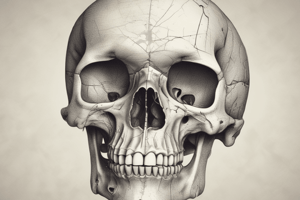Podcast
Questions and Answers
Match the parts of the skull with their functions:
Match the parts of the skull with their functions:
Cranial vault (calvaria) = Protects the brain Cranial base = Forms a protective cavity for the brain Acoustic skeleton = Related to the digestive and respiratory systems Facial skeleton = Protects the five special senses
Match the bones of the skull with their ossification method:
Match the bones of the skull with their ossification method:
Maxilla, Palatine, Zygomatic, Inferior concha, Nasal, Lacrimal, Parietal and Temporal = Intramembranous ossification Ethmoid, inf nasal concha, sphenoid, occipital (below the sup.nuchal line) = Endochondral ossification Vomer, frontal = Intramembranous ossification Mandible = Endochondral ossification
Match the cavities of the skull with their descriptions:
Match the cavities of the skull with their descriptions:
Cranial cavity = Protects the brain Nasal cavity = Related to the sense of smell Orbital cavity = Houses the eye Tympanic cavity = Related to hearing
Match the bones of the skull with their classification:
Match the bones of the skull with their classification:
Match the parts of the skull with their descriptions:
Match the parts of the skull with their descriptions:
Match the joints of the skull with their descriptions:
Match the joints of the skull with their descriptions:
Match the following bones with their corresponding region in the cranial cavity:
Match the following bones with their corresponding region in the cranial cavity:
Match the following structures with their corresponding location in the cranial cavity:
Match the following structures with their corresponding location in the cranial cavity:
Match the following foramina with their corresponding location in the cranial cavity:
Match the following foramina with their corresponding location in the cranial cavity:
Match the following bones with their corresponding region in the cranial base:
Match the following bones with their corresponding region in the cranial base:
Match the following structures with their corresponding clinical importance:
Match the following structures with their corresponding clinical importance:
Match the following bones with their corresponding region in the cranium:
Match the following bones with their corresponding region in the cranium:
Match the following facial bones with their descriptions:
Match the following facial bones with their descriptions:
Match the following types of facial fractures with their characteristics:
Match the following types of facial fractures with their characteristics:
Match the following bones with their functions:
Match the following bones with their functions:
Match the following types of facial bones with their numbers:
Match the following types of facial bones with their numbers:
Match the following facial bones with their locations:
Match the following facial bones with their locations:
Match the following facial fractures with their complications:
Match the following facial fractures with their complications:
Flashcards are hidden until you start studying
Study Notes
Osteology of the Skull
- The skull is a bony structure that supports the face and forms a protective cavity for the brain.
- Skull bones are formed by intramembranous ossification and joined by sutures (fibrous joints).
- The skull consists of 22 bones (excluding the ossicles), including 8 paired and 6 unpaired bones.
Cranium
- The cranium consists of the cranial roof and cranial base.
- The cranial roof is comprised of the frontal, occipital, and two parietal bones (also known as the calvarium).
- The cranial base is comprised of the frontal, sphenoid, ethmoid, occipital, parietal, and temporal bones.
- Fractures of the cranium typically arise from blunt force or penetrating trauma.
- The pterion, a H-shaped junction between the temporal, parietal, frontal, and sphenoid bones, overlies the middle meningeal artery and is an area of clinical importance.
Cranial Cavity
- The cranial cavity is divided into three regions: anterior, middle, and posterior.
- The anterior region houses the frontal lobe of the brain and consists of the frontal, ethmoid, and lesser wing of sphenoid bones.
- The middle region houses the hypothalamus, pituitary, and temporal lobe and consists of the greater and lesser wing, body of sphenoid, and petrous part of temporal bones.
- The posterior region houses the cerebellum, pons, and medulla oblongata and consists of the occipital, body of sphenoid, petrous, and mastoid parts of temporal bones.
Face
- The facial skeleton (viscerocranium) supports the soft tissues of the face and consists of 14 bones.
- The facial bones are: zygomatic, lacrimal, nasal, maxilla, and others.
- Fractures of the facial skeleton are relatively common and most frequently result from road traffic collisions, fist fights, and falls.
- The four most common facial fracture types are: nasal fracture, maxillary fracture, mandibular fracture, and others.
Clinical Relevance
- Fractures of the cranium can lead to extradural haematoma.
- Facial fractures can lead to soft tissue swelling, epistaxis, and other complications.
- Le Fort classification is used to classify maxillary fractures, ranging from 1 to 3.
Studying That Suits You
Use AI to generate personalized quizzes and flashcards to suit your learning preferences.



